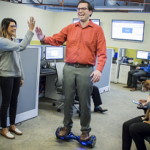This post also appeared in The Tennessean, where Concept Technology has a bi-weekly feature in the Business section.
When asked to envision the car of the future, you might conjure up science-fiction films like “Blade Runner,” “Knight Rider” or “Minority Report,” which all took their best stabs at where auto technology was going.
But we don’t have to turn to science fiction anymore — we already live in a world where driverless cars are a reality.
 I recently asked Joe Last, an engineer at Concept Technology and our resident expert on cars, about the technologies that are changing, improving and challenging the auto industry. Here’s what I learned.
I recently asked Joe Last, an engineer at Concept Technology and our resident expert on cars, about the technologies that are changing, improving and challenging the auto industry. Here’s what I learned.
Who are the big players driving technological advancements in the auto industry?
Apple, Google and Microsoft all have their hands in the latest technologies that enhance our driving experience. But more importantly, it’s public safety concerns that force technology providers to innovate in this space. As texting-related accidents and distractions increase, these technologies with help make our connected world safer.
In Tennessee, 10.6 percent of fatal car crashes involved cellphone use. How can technology reduce this statistic?
Within the next year, we will see heavy integration of smartphones into car dashboards. Technologies like Apple CarPlay and Android Auto take the things you want to do with your smartphone while driving — place calls, send texts, find a route to your destination, play music, etc.— and puts them right on your car’s built-in display. By using Siri or Google Now to activate your phone through your car, you can keep your hands on the steering wheel and eyes on the road.
This technology is available now on select new cars, and you’ll soon be able to add it to your current car with an aftermarket system.
What else is on the market right now, in terms of car technology?
Many new cars currently have adaptive cruise control, which uses forward-looking radar, installed behind the grill of your car, to detect the speed and distance of the car ahead of it. With adaptive cruise control, you can set your cruise to follow the car ahead of you, and your car moderates the speed itself.
It’s also becoming standard to integrate some mobile apps, such as Pandora, into a car’s dashboard.
What kind of knowledge and budget do you need to incorporate this existing technology into your car?
Up until recently, only techies and hobbyists would find it fun or worth the time and money to build connected technologies into their vehicles. For example, I integrated an iPad mini into my 2009 Subaru Impreza WRX to use as a navigation, communication and media playback device. I did most of the work myself. If I had hired someone to do it, I estimate the work would cost around $1,500 to $2,000, which is comparable to the cost of a factory navigation system.
This functionality will soon come bundled with cars, and the same method of integration can be applied to any smartphone as well.
What do we need to know about connected cars?
Several technology providers and carmakers are working on a project called CarTALK 2000, which will allow cars to communicate with one another to avoid accidents and help regulate traffic and speed. This project uses Wi-Fi technology to connect the cars.
What do we need to know about driverless cars?
Driverless cars are already on the road, in testing at least, and almost every major automaker is working on them. If you saw the 2013 movie “The Internship,” starring Vince Vaughn and Owen Wilson, you got a glimpse at Google’s driverless car. (Google actually nixed a scene in the movie that showed a Google driverless car crashing.)
Most industry sources indicate semi-automated cars will be available as early as 2016. Within five years, we could see fully automated cars on the roads, unless government regulation hampers the technology.
photo credit: alexbartok via photopin cc

